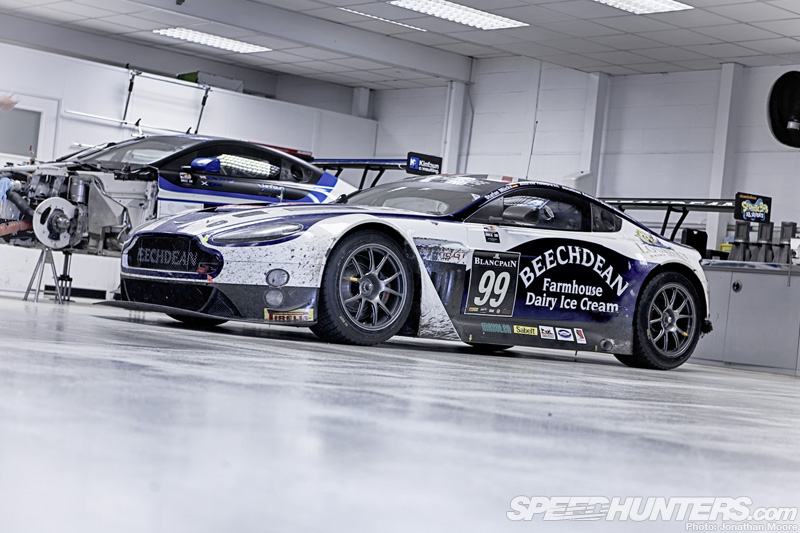
The words ‘Aston Martin’ and ‘Racing’ go together: this is a company whose birth a century ago came about through the desire for competition, and who have tested almost every car they’ve made by throwing it straight into the crucible of motorsport from prototype stage onward. Since returning to their natural territory of GT racing in 2005 with the DBR9 GT1, the company have got involved in every tier of FIA’s GT ladder, from the near-stock GT4 category right up to the fire-breathing monsters of GT1. Their most recent racing machine is this, the Vantage V12 GT3, which first ran in November 2011. It wasn’t Aston Martin’s first foray into the category: they were one of the first teams out of the blocks with a GT3 car back in 2006 with the DBRS9, and have always had strong representation in both national and European series.

This Vantage GT3 is run by Beechdean Motorsport, and its normal home is in the hotly contested British GT Championship – but I caught up with it and the remains of a fair proportion of Belgium’s insect population (and the blood of its victims) just after it had returned from a gruelling Spa 24 Hours.
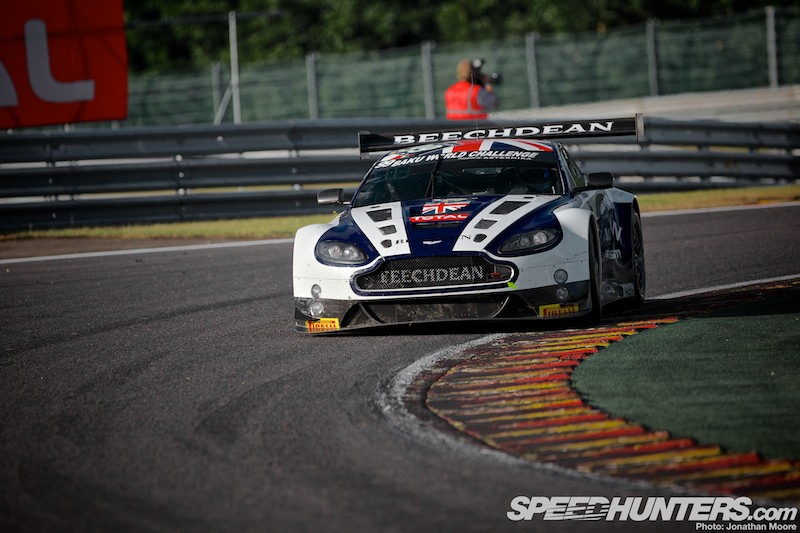
With Stefan Mücke on loan from the factory squad, the Beechdean Vantage scored an unexpected pole position, and led for the initial phase of the race until a puncture and then related problems dropped it down the order. The crew of Mücke, regular British GT drivers Andrew Howard and Johnny Adam, and new recruit Daniel Mackenzie fought back to bring the car home in 23rd place after 24 hours.
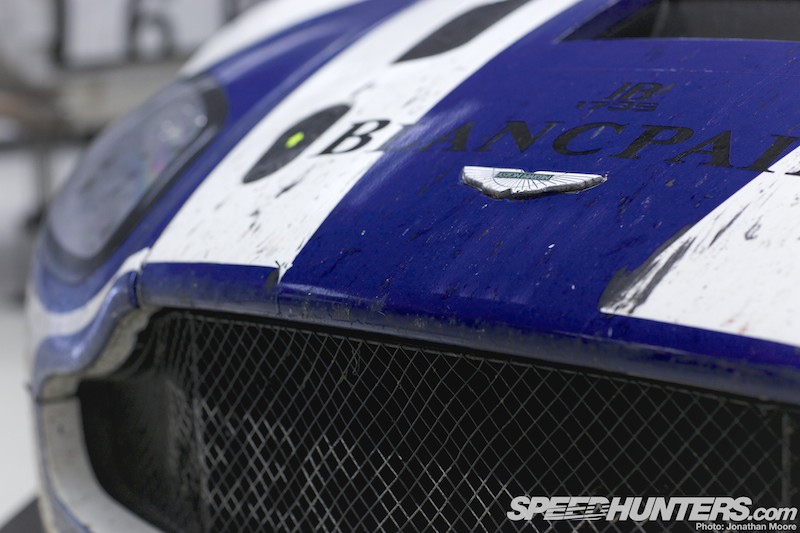
And this is what it looked like on its return to the UK homebase. It was actually in pretty good shape: testament to the strength of the Vantage and its components, and the hard work of the team through the day-long race.
Chassis X3 was originally the factory development car. Andrew Howard – driver, team owner and boss of the Beechdean Dairy – bought the car in 2012 and has campaigned it hard in the UK and select European events. He also owns X1, which was the DBRS9 dev car. The Vantage has been updated to full 2013 specification, which compared to a lot of the GT3 competition was actually a very mild update.
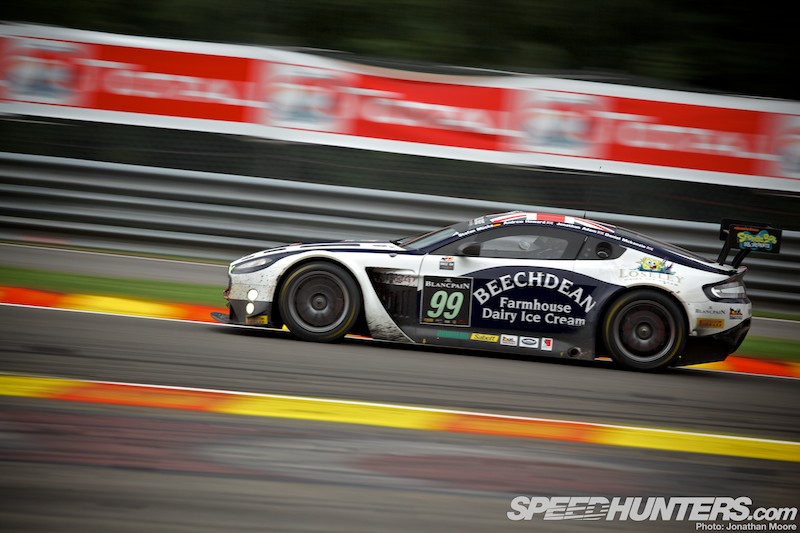
One of the biggest parts of the GT3 formula is performance balancing. Although the rules set for GT3 is pretty open (which is what encourages manufacturers to dive in with such disparate cars), a Balance Of Performance test at the beginning of the year is backed up by reviews through the season to keep competition tight.
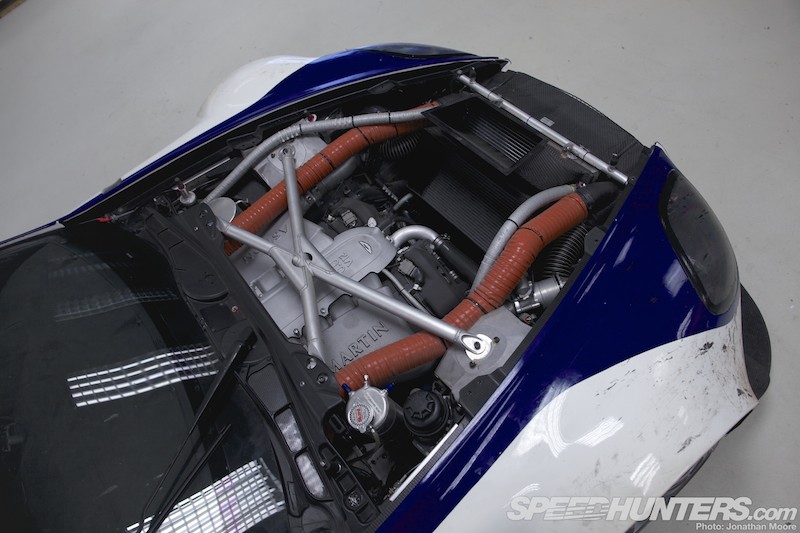
This makes producing big updates each year a bit of a pointless process: make your car three seconds faster with more power or trick aero for instance, and the rule-makers will simply reduce its performance back down. This is the main reason why Aston Martin’s 2013 update was more focussed on reliability and power delivery (the major changes being with the 40mm FIA restrictor and clutch) rather than the big aero packs seen on a number of rival 2013 GT3s. The company know that the power of the V12 (over 600hp and 700nm of torque) can always be turned up as necessary, so avoiding imposing expensive upgrades on customers.
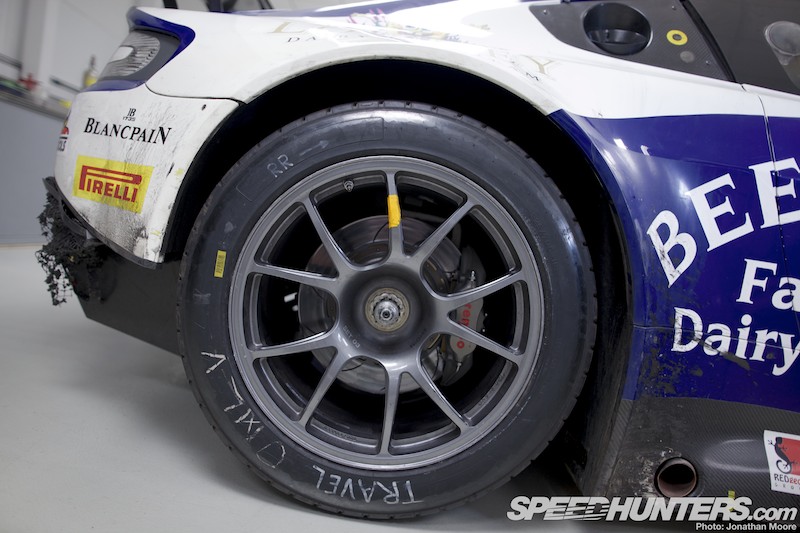
There are around 19 Vantage GT3s competing around the world; last year the cars took two championships and 18 race wins, and this year have already added another 14 wins to the tally. One of the biggest changes in recent years has been the ability of GT3s to compete in and complete 24-hour races: something they were simply not built to do in the original spec – these were supposed to be relatively simple GTs aimed at pro-am sprint races.
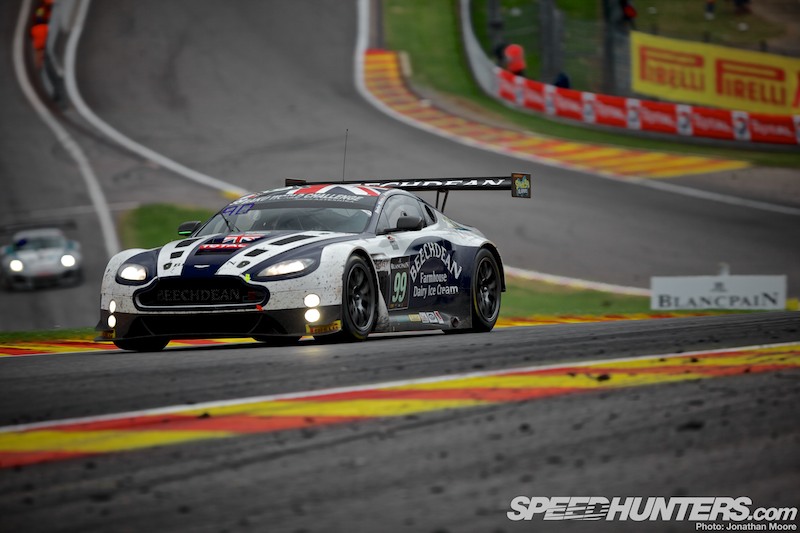
But with a number of big endurance races adopting GT3 rules (Spa, Nürburgring, Dubai), all the manufacturers have produced endurance kits for their cars. Aston Martin’s Vantage has proved not only fast but more importantly durable in the endurance arena.

So what do you get for your €350,000? The origin of the Vantage GT3 was a direct roll-over from Aston Martin’s GT1 and GT2 programmes, all overseen by AMR’s long-term racing partner Prodrive. GT3 looks likely to become the core GT spec, with in all likelihood a higher-level GT (ie, what is currently GTE) based on a base GT3 car with an update kit of more advanced aero and carbon components – hence why the Vantage GT3 is such an important car for AMR. Strangely, carbon brakes aren’t allowed in GT3, despite it being generally accepted that using them is actually cheaper over a season: you have to change them far less than regular steel units.

The Vantage GT3 uses Brembo ventilated discs and Performance Friction are the standard pad option with Endless for endurance races – though Pagid were used at the Spa 24 along with lightweight front calipers: six-pot up front and four at the rear. Brake bias is adjustable from the cockpit of course, as are the ABS and traction control; the latter are again part of the GT3 spec.

The aids are deliberately in place to help the drivers in GT3, a fair proportion of whom are gentleman driver/owners who employ full-time pros alongside them. These might make the car a little less tricky and edgy than a GTE and help balance amateur and professionals, but that doesn’t mean that the Vantage is easy – or slow. In fact, running unrestricted (as some private owners of Vantages do, running just track days), a GT3 car could keep up with its GTE big sister.
The Vantage’s traction control is set up to be less intrusive than many others: apart from reducing a driver’s reliance on it, it also helps with fuel economy. At Spa, you could hear a number of cars hacking away as their TC saved the car from stepping out… The ABS is controlled via a standard Bosch system, which the majority of the grid use.
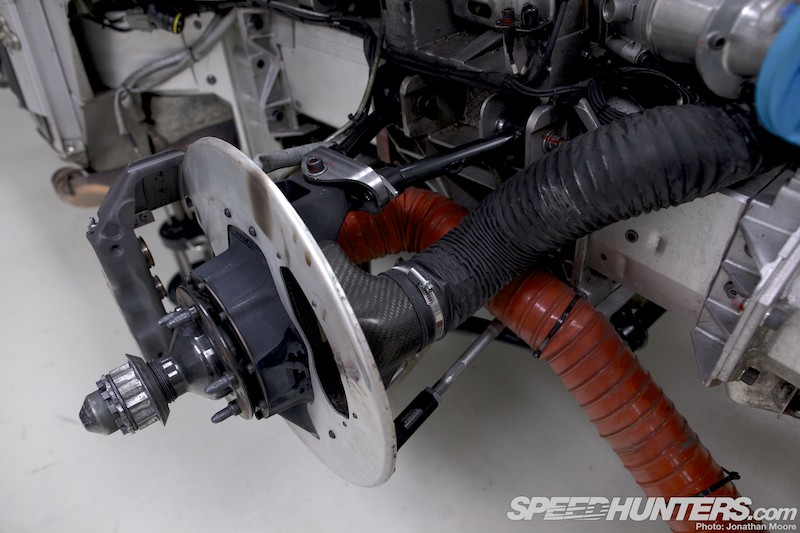
The suspension is simple and robust: double wishbones with uniball bearings and two-way adjustable Koni dampers front and rear. AMR manufacture in-house their own forged aluminium uprights, cam blocks, lower track control arms and compression struts.
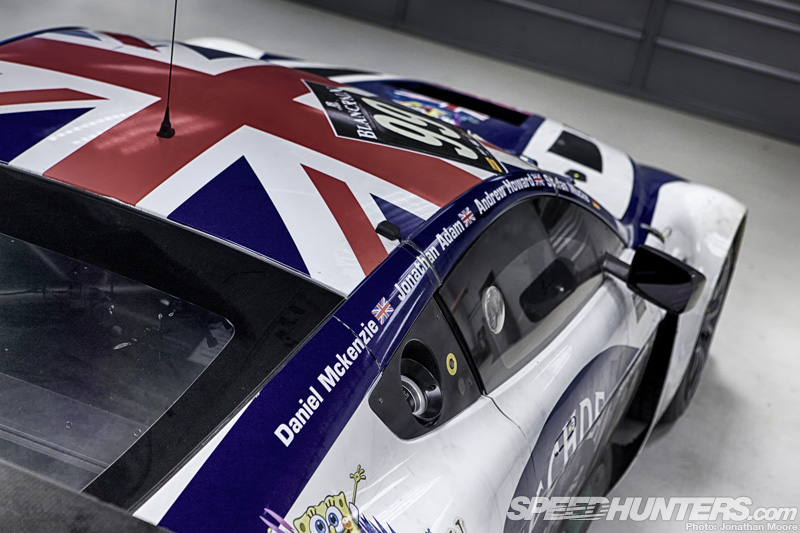
The other part of the endurance-spec kit is the quick-fill fuel system, which reduces fill time by around 20 percent – a critical time saving in any GT race. That includes a new fill pipe and lift pump; the positioning of the dump valve and vent can be swapped round depending on pit requirements. This side of the car also has the jack for the ECU and data system and an IR lap beacon that triggers the receiver mounted on the pitwall. The cable running onto the roof is for the series GPS logger.
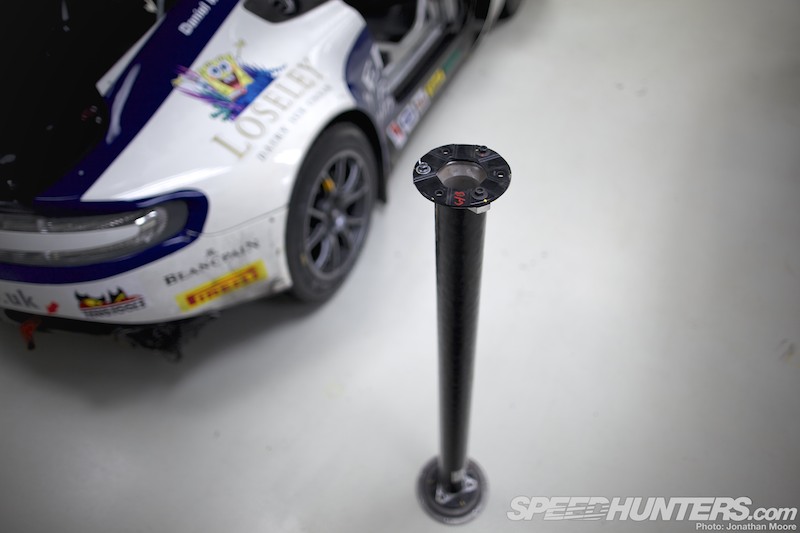
So what are the actual differences between a GT3 and GTE Vantage? Well, apart from the several hundred thousand Euro increase in price, the core seems quite similar: the chassis, tub and roll cage is effectively the same, as is the gearbox and carbon prop. But then the two diverge dramatically: in the GTE car all the ancillaries have been moved to the rear to help with weight distribution and the control systems are mounted in the passenger well for easy quick changes, whereas the Vantage GT3 retains a fair amount of the general production car layout.
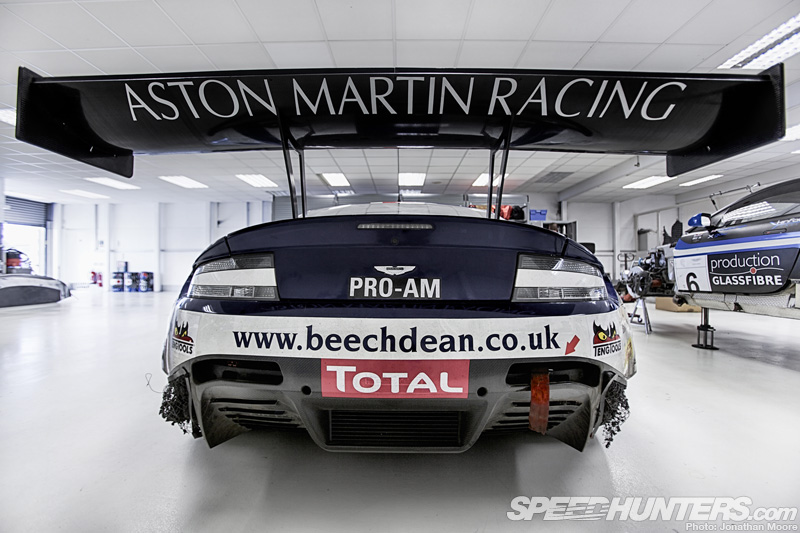
The aero is more highly tuned on the GTE car, with a flat floor and lower rear wing. As is typical with a GT3 car, the biggest thing in every sense is the rear wing. Mounted high up at the back in the cleaner air, it fits the maximum dimensions allowed.
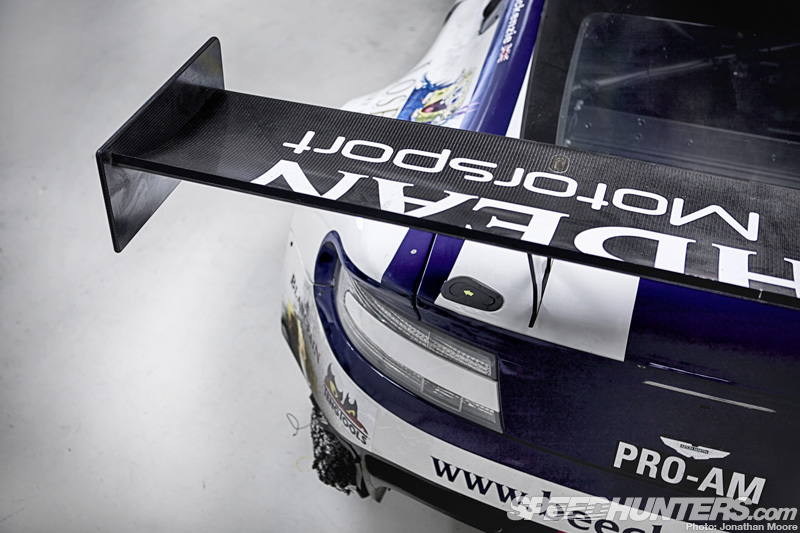
There are five positions, which might seem few compared to the dozens of combinations on, say, the Audi R8 LMS or GT-R, but again the Vantage is designed to be easy to tune. With such a big wing, small alterations can make a big difference, and limited running time on GT3 race weekends just doesn’t normally justify having hugely complex aero packages.
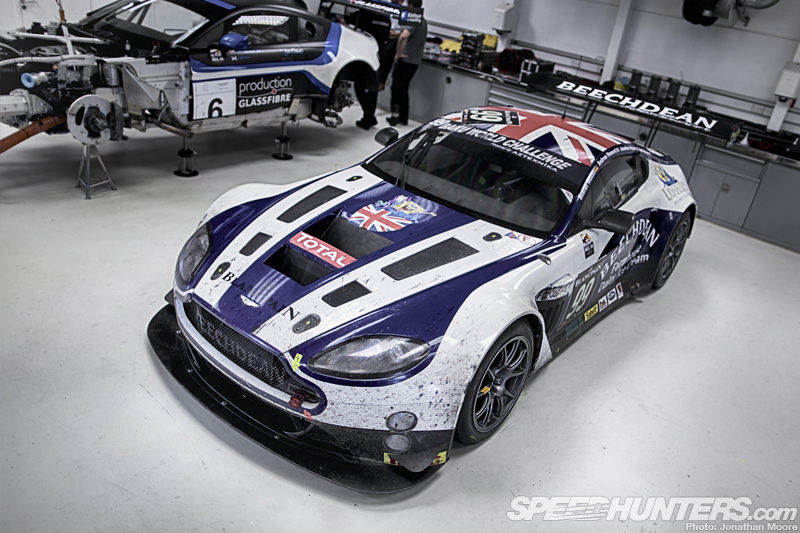
Roof aside, the Vantage bodywork is all carbon over a bonded aluminium chassis, with the windscreen a heated glass piece – polycarbonate isn’t allowed under FIA GT3 rules. The biggest difference is what’s under the bonnet. The lightweight V8 of the GTE is smaller but less powerful; the GT3 Vantage packs a howling 6 litre V12. Under the bonnet, it all looks quite spacious up front – and surprisingly simple in relative terms.
A lot of this is about maintenance: a lot of other manufacturers have gone overboard on the outside with aggressive-looking aero but left what’s underneath close to production spec, making access particularly difficult for the mid-engine cars like the Audi and McLaren. Mechanics seem to generally find the Vantage easy to work on, with the things you need to get to quickly during a race – oil and water top-ups in particular – in obvious, easy to get to positions.
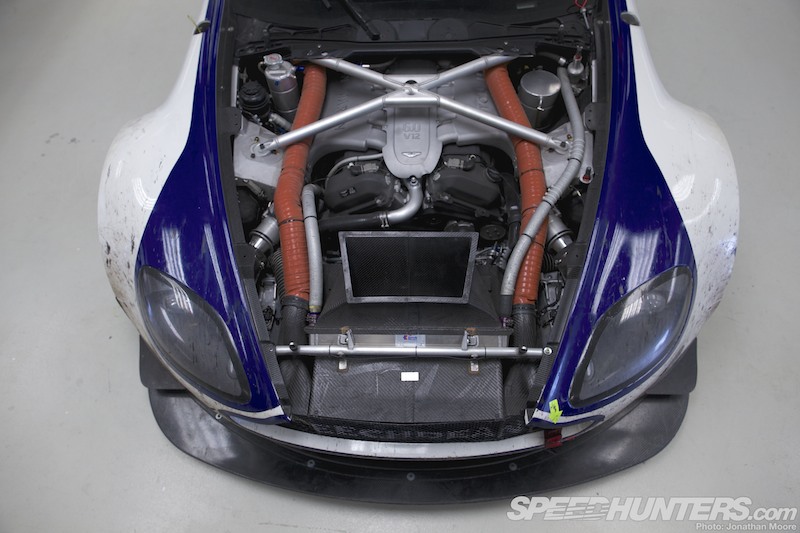
The engine can be removed in about two hours, by removing the bodywork and cooling and splitting off the front crash structure. A freshly rebuilt V12 (and Xtrac gearbox with limited slip diff) ran for the whole of race week at Spa, and the engine was due to stay in for at least another two races. It’s all part of the cost control for GT3: there might not be actual price restrictions, but there’s an effective cap as if your car is too expensive to purchase and then run no one will buy it!
Mounted as far back and as low down as the rules now allow (the DBRS9 engine position was much closer to the road car), the dry-sumped six-litre V12 may be based on the production unit but Aston Martin Racing tune the engine up to produce over 600hp. The block, manifold, crank and inlet covers are all standard. The Vantage manages close to the golden goal of 50-50 weight distribution. At its 1250kg base, it’s 430kg lighter than the production V12 Vantage.
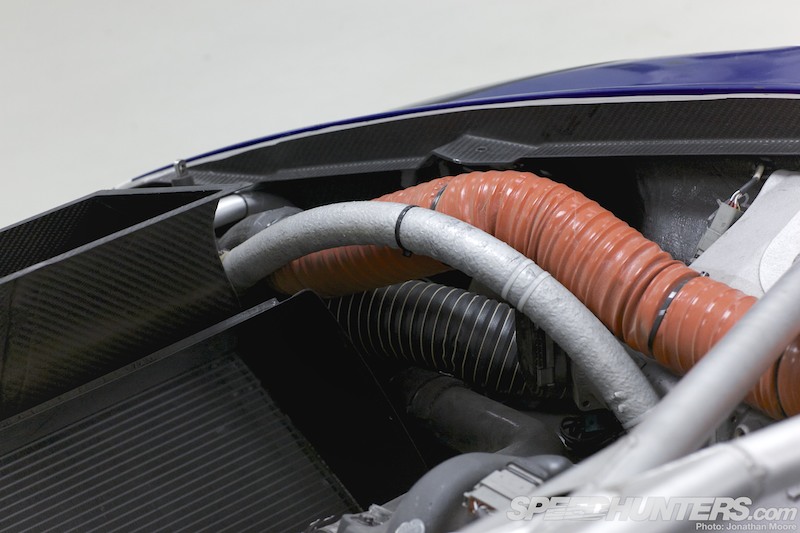
The nose is really all about cooling: various hoses run off the front ducts. On the left, brakes and oil, and the right, the other brake hose and one for the cockpit. The hydraulic power steering is from the standard road car, which has proved up to the job, and the standard catalyst is mounted down low, tucked behind the right-side gills behind the front wheel. It’s another example of only improving (ie, asking customers to spend money) on what’s really necessary.
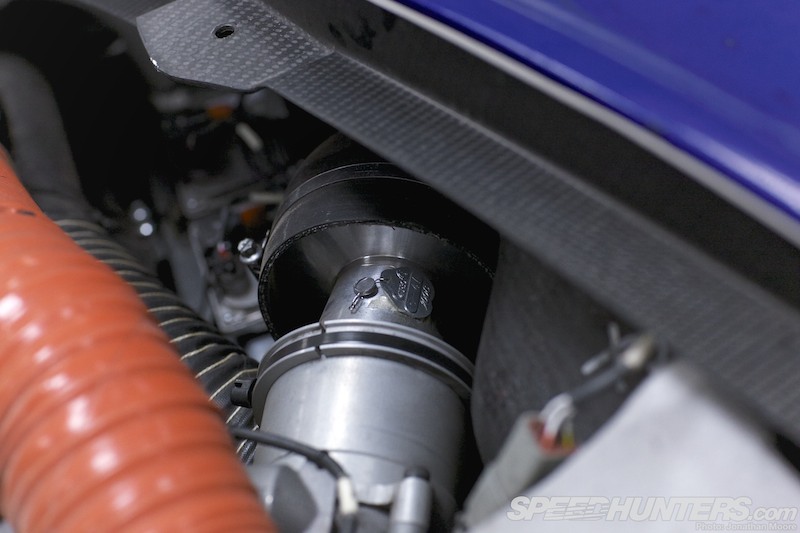
Throttle bodies are run on extensions because of the engine mounting position, and the Cosworth ECU is down in the left-rear of the engine bay, and oversees traction control, engine management and gearshifts: most of Aston Martin’s GTs use it. The restrictors are sealed and checked at scrutineering.
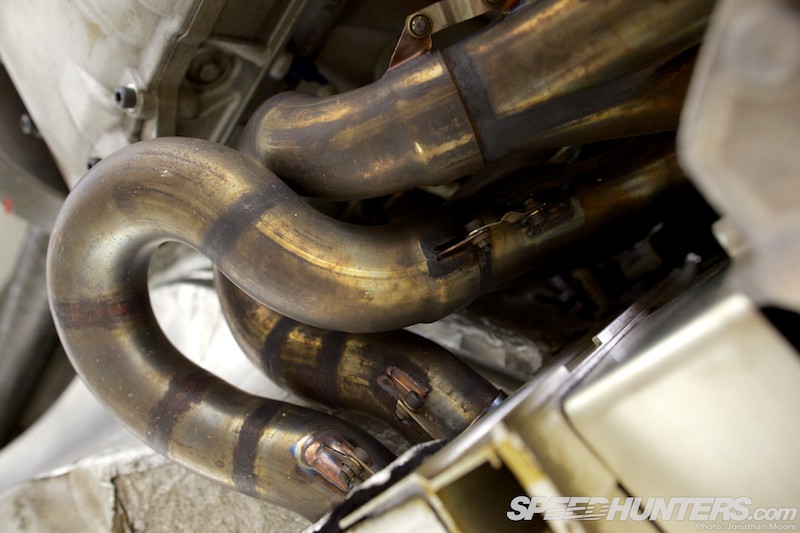
The exhausts are rather more bespoke: they pass through a silencer before making their way to a side exit near the rear fender.

At the rear there’s a pseudo-diffuser, though it’s more for styling than actual aero performance – as usual, BOP means that Aston Martin just don’t believe it’s a route worth pursuing, as opposed to cars like the Ferrari 458 Italia which run large diffusers. It’s another thing that can – and likely will – get damaged during a race. In AMR’s view it’s a simple equation: more speed equals more ballast equals more brakes and fuel.
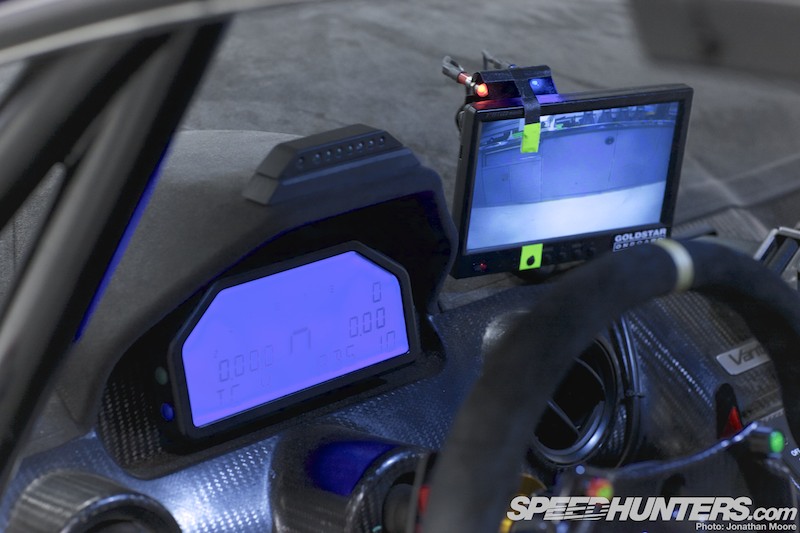
The Beechdean Vantage uses an off-the-shelf rear view camera linked to a screen in the cockpit, with the camera mounted just below the central brake light. It’s not standard on the Vantage, but Beechdean have always run with the system: with limited rear view in most GT cars, it’s just a sensible thing to do.
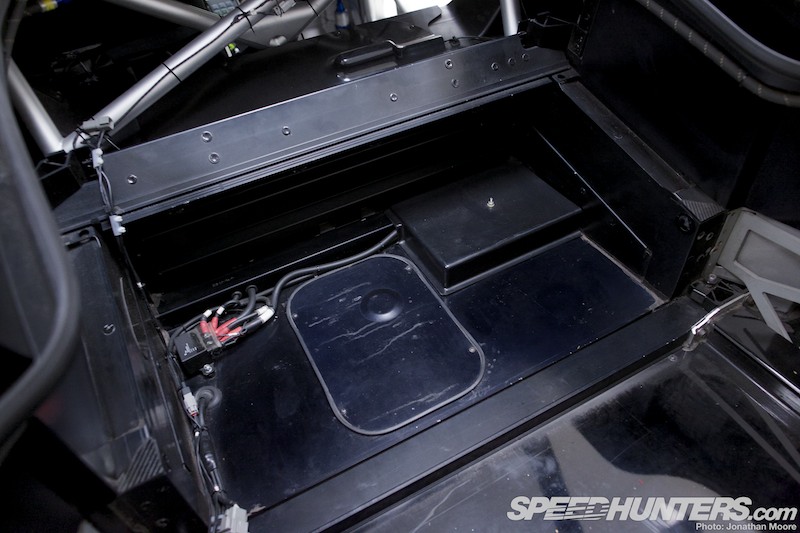
In the boot, compared to the GTE it’s cavernous: the battery is mounted under the cover in the top right, the gearbox quick-access hatch in the middle and master relay on the left. The batteries are now Super B Lithium, which the team have found incredibly durable: they’ve even had alternator failure in a race but the battery still got them to the end.

The cockpit is all business: stripped down, with a bare carbon finish. With the driver tucked down low in the seat, the cabin is set up to make everything as easy to access as possible. Beechdean added a driver net for Spa, which isn’t yet mandatory but which the team were trialling. For the added security it didn’t provide any obstacle for the drivers, and it’s something that is likely to be obligatory in the future. In the passenger well, there’s the radio and series data logger, along with the unit controlling the LED number panel run at Spa and ballast plate.
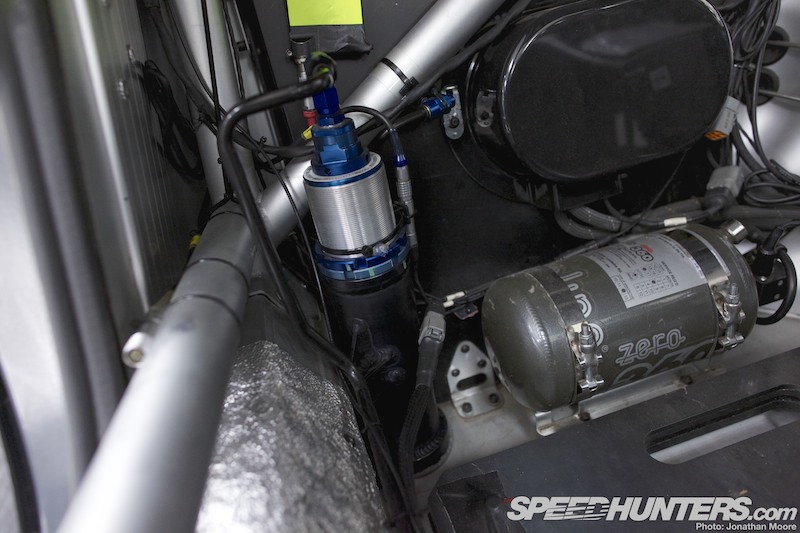
The 114-litre quick-release fuel cell is mounted in the rear of cabin, across the transmission tunnel, with the high speed pneumatic air jacks in each corner of the cockpit.
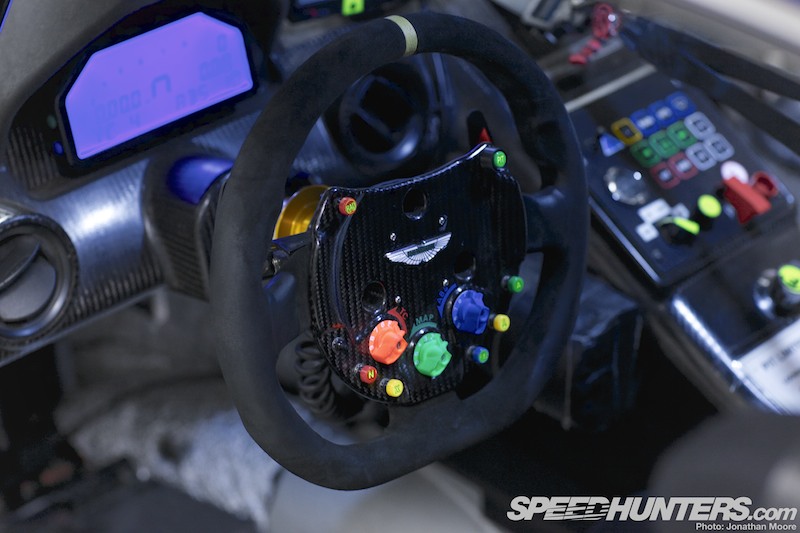
The central console is really only used in the pit lane: the major features being the ignition and then the standard starter button straight out of a production Aston. Everything crucial is on the steering wheel. Dials control ABS, engine map and traction control; thumb switches for the pit limiter and radio PTT; buttons for fuel reset, dash display page, alarm acknowledge, wipers, neutral and headlight strobe. Paddles control the six-speed semi-auto Xtrac ‘box.

The team added a soft light in the cockpit to help during pitstops, and there’s also an IR lamp for night driving that helps illuminate the controls.

The floor-mounted pedal box is standard AP kit, with the typical guard on the throttle to help prevent your foot slipping.
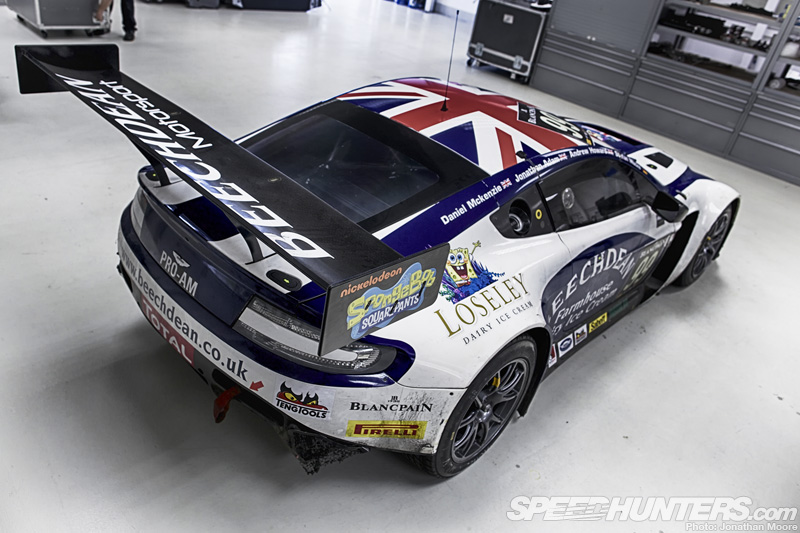
A week and a half later, and the Beechdean Aston Martin Vantage GT3 was back in action in the British GT Championship at Brands Hatch. Cleaned and prepped, Andrew Howard and Johnny Adam again sat on the front row, but this time converted it into victory – and the championship lead. It looks like they’ll be plenty more victories for Aston Martin Vantage GT3s before the season is out.
Jonathan Moore
Instagram: speedhunters_jonathan
jonathan@speedhunters.com
Aston Martin theme on Speedhunters
More Aston Martin stories on Speedhunters
ASTON MARTIN VANTAGE GT3
Numbers
Power >600hp, Torque >700Nm, dry weight 1,250kg with near 50:50 weight distribution
Engine
Lightweight six-litre V12, dry sump oil system, engine repositioned to optimise weight distribution
Driveline
Xtrac six speed sequential transmission, racing clutch, limited slip ramp/plate differential, easily accessible drop gears, semi-automatic paddle shift gear change, carbon fibre propshaft
Suspension/Brakes
Double wishbone suspension with uniball bearings, two-way adjustable dampers front and rear, optimised geometry for lower race ride height, six-pot front calipers, four-pot rear calipers, ventilated front and rear brake discs, manually adjustable front/rear brake bias, race developed ABS and traction control
Wheels/Tyres
12.5″ x 18″, with 30/68-18 tyres (front), 13″ x 18″, with 31/71-18 tyres (back)
Exterior
Lightweight aluminium chassis, front splitter, adjustable full width carbon fibre rear wing, aerodynamically optimised bumpers, side sills and rear fenders, removable carbon-fibre body panels, aluminium roof
Interior
Steel roll cage to FIA safety standards, high speed pneumatic jack system,114-litre fuel cell to FIA safety standards, twin quick release couplings, hydraulic power assisted steering, quick release steering wheel, six-point safety harness, adjustable seat position, lightweight battery, carbon fibre dash, fire extinguisher system, driver display and shift lights






The photos in this post are masterpieces.